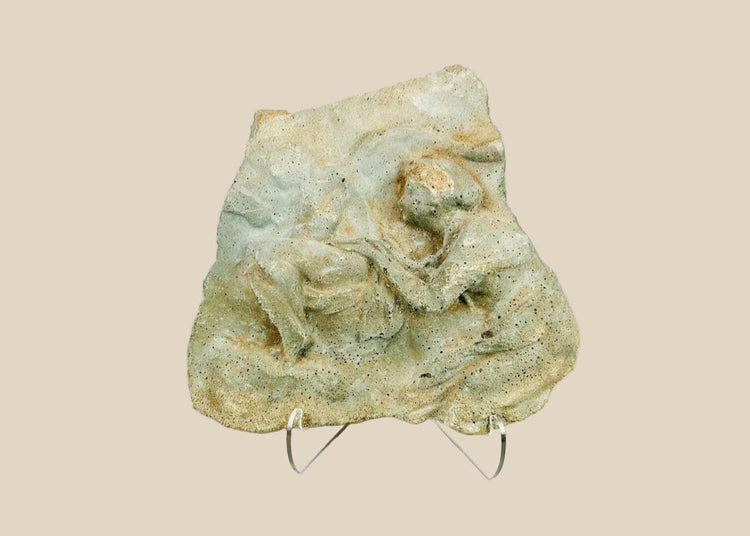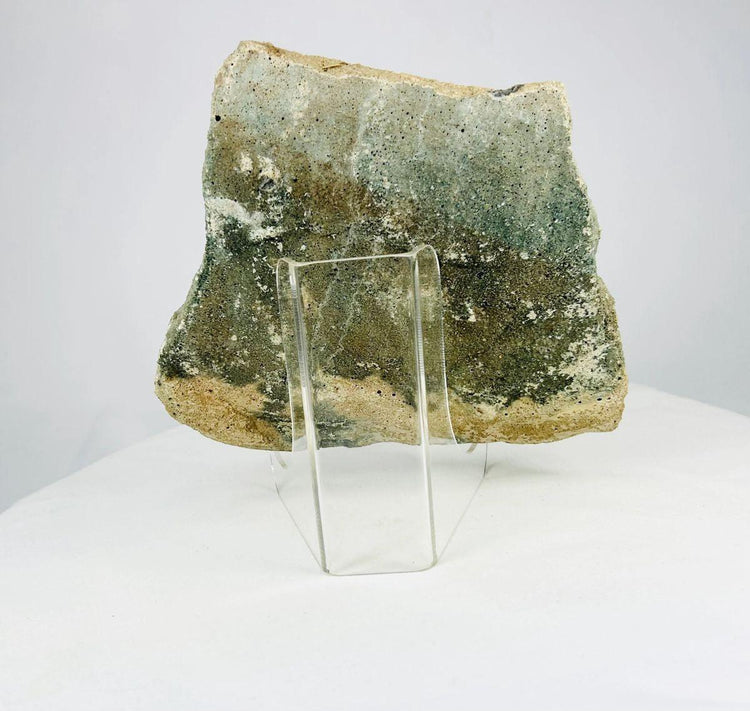Classical Limestone Relief Fragment | Two Carved Human Figures | Mediterranean or Near Eastern | 500 BCE–500 CE
Description
More
Less
Historical Context & Origin
Region: Mediterranean or Near East
Material: Carved limestone
Period: Classical Period, circa 500 BCE–500 CE
Description
This ancient carved stone relief fragment presents two human figures rendered in soft yet expressive detail. The figures, delicately carved with visible emotion, suggest that the relief once formed part of a larger narrative scene, possibly mythological or commemorative in nature. Its refined style reflects the storytelling traditions of Classical Mediterranean and Near Eastern civilizations.
Features
- Depiction of two carved human figures with expressive detail
- Weathered surface with mineral deposits from centuries of aging
- Likely part of a larger architectural or narrative composition
- Compact size suitable for display while retaining historical impact
Cultural Significance
Stone reliefs were central to the artistic and cultural identity of Classical civilizations. They were often integrated into temples, tombs, or public spaces, serving both decorative and symbolic functions. This fragment connects directly to the narrative traditions of the ancient world, where carved imagery conveyed stories of gods, heroes, and significant historical events.
Condition
The relief is in stable ancient condition, with surface weathering and patina consistent with prolonged exposure and age. Minor chipping and wear do not detract from the legibility of the figures, instead adding to its authenticity and historic character.
Dimensions (approximate)
Height: 7.5 in
Width: 7 in
Age
Classical Period, circa 500 BCE–500 CE
Learn More
See a Similar Piece at The Metropolitan Museum of Art
Explore Other Limestone Fragments in Our Collection: Egyptian Carved Limestone Hieroglyphic Fragment 7th Century BCE and Limestone Canopic Jar Lid Fragment of Imsety Circa 1550–1070 BCE
Description
Historical Context & Origin
Region: Mediterranean or Near East
Material: Carved limestone
Period: Classical Period, circa 500 BCE–500 CE
Description
This ancient carved stone relief fragment presents two human figures rendered in soft yet expressive detail. The figures, delicately carved with visible emotion, suggest that the relief once formed part of a larger narrative scene, possibly mythological or commemorative in nature. Its refined style reflects the storytelling traditions of Classical Mediterranean and Near Eastern civilizations.
Features
- Depiction of two carved human figures with expressive detail
- Weathered surface with mineral deposits from centuries of aging
- Likely part of a larger architectural or narrative composition
- Compact size suitable for display while retaining historical impact
Cultural Significance
Stone reliefs were central to the artistic and cultural identity of Classical civilizations. They were often integrated into temples, tombs, or public spaces, serving both decorative and symbolic functions. This fragment connects directly to the narrative traditions of the ancient world, where carved imagery conveyed stories of gods, heroes, and significant historical events.
Condition
The relief is in stable ancient condition, with surface weathering and patina consistent with prolonged exposure and age. Minor chipping and wear do not detract from the legibility of the figures, instead adding to its authenticity and historic character.
Dimensions (approximate)
Height: 7.5 in
Width: 7 in
Age
Classical Period, circa 500 BCE–500 CE
Learn More
See a Similar Piece at The Metropolitan Museum of Art
Explore Other Limestone Fragments in Our Collection: Egyptian Carved Limestone Hieroglyphic Fragment 7th Century BCE and Limestone Canopic Jar Lid Fragment of Imsety Circa 1550–1070 BCE
You May Also Like

















